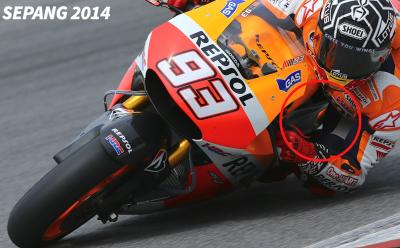Marc Marquez: Cornering through time
Marc Marquez has taken MotoGP by storm since his arrival in the premier-class in 2013.
Winning the title in six out of the seven seasons since, the Spaniard has remained with Repsol Honda throughout but still needed to adapt from Bridgestone to Michelin tyres, open electronics to a control ECU, plus the introduction of wings.
Famous for extreme lean angles and breath-taking saves, Marquez's spectacular style looks to have undergone only minor changes during his time in the premier-class.
Marc Marquez has taken MotoGP by storm since his arrival in the premier-class in 2013.
Winning the title in six out of the seven seasons since, the Spaniard has remained with Repsol Honda throughout but still needed to adapt from Bridgestone to Michelin tyres, open electronics to a control ECU, plus the introduction of wings.
Famous for extreme lean angles and breath-taking saves, Marquez's spectacular style looks to have undergone only minor changes during his time in the premier-class.
That's not surprising given the success he has enjoyed with the aggressive elbow-down cornering technique now used by much of the grid.
If anything, Marquez appears to be positioning his body even further off the bike in recent years. His lean angles have certainly been bigger than ever, including a new record of 66 degrees at Sachsenring 2019 (then a massive 70 degrees while saving a fall at Phillip Island later in the year) as he worked harder to make the RCV turn.
"The reason why we are using so much lean is because the bike is not turning," Marquez explained. "So I use all this lean angle not because it's my [natural] riding style, not because I like it, but because I need to."
Already a winner of 56 MotoGP races, Marquez has the chance to join Valentino Rossi on seven premier-class titles this season, which would leave only Giacomo Agostini (8) ahead in the record books.
Latest 2020 MotoGP Calendar (including free weekends) | |||
Round | Date | Race | Circuit |
8 March | Qatar (MotoGP cancelled) | Losail | |
| France (postponed) | Le Mans | |
| Italy (postponed) | Mugello | |
| Catalunya (postponed) | Barcelona | |
| Germany (cancelled) | Sachsenring | |
| Netherlands (cancelled) | Assen | |
| Finland (cancelled) | KymiRing | |
1 | 19 July | Spain (proposed) | Jerez (rescheduled) |
2 | 26 July | Andalusia (proposed) | Jerez |
| 2 August |
|
|
3 | 9 August | Czech Republic | Brno |
4 | 16 August | Austria | Red Bull Ring |
23 August | |||
5 | 30 August | Great Britain | Silverstone |
6 September | |||
6 | 13 September | San Marino | Misano |
20 September | |||
7 | 27 September | Aragon | Aragon (rescheduled) |
8 | 4 October | Thailand | Buriram (rescheduled) |
11 October | |||
9 | 18 October | Japan | Motegi |
10 | 25 October | Australia | Phillip Island |
11 | 1 November | Malaysia | Sepang |
8 November | |||
12 | 15 November | Americas | COTA (rescheduled) |
13 | 22 November | Argentina | Termas de Rio Hondo (rescheduled) |
14 | 29 November | Valencia | Ricardo Tormo (rescheduled) November seen as cut-off for European races |
| 6 December |
|
|
| 13 December |
| Mid-December seen as cut-off for races outside Europe |



![Johann Zarco, LCR, Honda RC213V, 2024 San Marino MotoGP, Misano, action [Gold & Goose]](https://cdn.crash.net/styles/thumbnail/s3/2024-09/GnG_1166323_HiRes.jpg?itok=vpgrU7Q4)

![Jack Miller, KTM Factory Racing, KTM RC16, San Marino MotoGP, Misano, action [Gold & Goose]](https://cdn.crash.net/styles/thumbnail/s3/2024-09/GnG_1167624_HiRes.jpg?itok=iz7mA4EQ)


![Fabio Quartararo, Monster Energy Yamaha Racing, Yamaha M1, 2024 MotoGP, Misano Test, action [Gold & Goose]](https://cdn.crash.net/styles/thumbnail/s3/2024-09/GnG_1168928_HiRes.jpg?itok=fcYSole_)
![Toprak Razgatlioglu, ROKiT BMW Motorrad, BMW M 1000 RR, Magny-Cours, WorldSBK [Gold & Goose]](https://cdn.crash.net/styles/thumbnail/s3/2024-09/GnG_1165133_HiRes.jpg?itok=GD5SVNVG)

